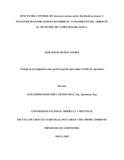Mostrar el registro sencillo del ítem
Efecto del control de Steneotarsonemus spinki, Burkholderia glumae y Fitotoxicidad por glifosato sobre el vaneamiento del arroz en el municipio de Campoalegre, Huila.
| dc.contributor.advisor | Caicedo Diaz, Guillermo Edmundo | |
| dc.coverage.spatial | ccav_-_neiva | spa |
| dc.creator | Muñoz Gomez, José Eduin | |
| dc.date.accessioned | 2019-05-06T21:48:00Z | |
| dc.date.available | 2019-05-06T21:48:00Z | |
| dc.date.created | 2019-04-23 | |
| dc.identifier.uri | https://repository.unad.edu.co/handle/10596/25412 | |
| dc.description.abstract | Uno de los principales cultivos del departamento del Huila es el arroz, el cual representa hasta el 4,7% del arroz mecanizado a nivel nacional (DANE-FEDEARROZ, 2017 citado por Bravo, 2018), siendo el municipio de Campoalegre el mayor productor en este departamento. En los últimos diez años se ha incrementado el vaneamiento del grano lo cual ha causado reducciones de la producción. Esta pérdida se ve reflejada de manera negativa en la calidad de vida de los cultivadores de arroz. No se sabe en esta localidad el factor causante del vaneamiento del arroz, sin embargo, existen varias hipótesis sobre la casusa de vaneamiento entre las que se encuentran la batería Burkholderia glumae, el acaro Steneotarsonemus spinki y la intoxicación con glifosato. El objetivo de esta investigación consistió en evaluar el control el S. spinki, B. glumae con los productos químicos (Abamectina y Oxilobac u Ácido Oxolítico) y el efecto de la intoxicación con glifosato sobre el vaneamiento del arroz variedad Fedearroz 2000. Se realizó una distribución en bloques completos al azar con tres repeticiones. Los tratamientos consistieron en T1: control químico del acaro-bacteria, T2: sin control del acaro-bacteria, T3: Intoxicación con glifosato. Las variables evaluadas fueron el número de granos llenos (GLL), el número de granos vanos (GV), el porcentaje de vaneamiento (%GV) y producción (PR). Para GV, %GV y PR no se encontraron diferencias estadísticas entre tratamientos, sin embargo, la producción general (6,8 Ton/ha) rondó el promedio regional y el vaneamiento estuvo por debajo del 15% indicado como límite máximo tolerable sin diferencias significativas por lo que se puede concluir que los factores evaluados no incidieron en estas variables. Únicamente se encontró diferencias estadísticas al 95% de confianza en GLL en el cual, el control del acaro-bacteria con los productos químicos presentó el mayor número de granos llenos por panícula sin diferencias estadísticas con el tratamiento correspondiente a intoxicación con glifosato. | spa |
| dc.format | spa | |
| dc.format.mimetype | application/pdf | spa |
| dc.language.iso | spa | spa |
| dc.publisher | Universidad Nacional Abierta y a Distancia UNAD | spa |
| dc.title | Efecto del control de Steneotarsonemus spinki, Burkholderia glumae y Fitotoxicidad por glifosato sobre el vaneamiento del arroz en el municipio de Campoalegre, Huila. | spa |
| dc.type | Proyecto de investigación | spa |
| dc.subject.keywords | Cultivo, Arroz, Bacteria, Enfermedad de las plantas | spa |
| dc.description.abstractenglish | One of the main crops of the department of Huila is rice, which represents up to 4.7% of mechanized rice nationwide (DANE-FEDEARROZ, 2017 citado por Bravo 2018), with the municipality of Campoalegre being the largest producer in this department. In the last ten years the grain vaneamiento has increased which has caused production reductions. This loss is reflected negatively in the quality of life of rice growers. The causal factor of the rice vaneamiento is not known in this locality, nevertheless, there are several hypotheses about the cause of vaneamiento between which are the battery Burkholderia glumae, the acarus Steneotarsonemus spinki and the intoxication with glyphosate. The objective of this investigation was to evaluate the control of S. spinki, B. glumae with the chemicals (Abamectin and Oxolytic Acid) and the effect of glyphosate intoxication on rice vaneamiento variety Fedearroz 2000. A distribution was made in Complete random blocks with three repetitions. The treatments consisted of T1: chemical control of the mite-bacterium, T2: without control of the mite-bacterium, T3: Intoxication with glyphosate. The variables evaluated were the number of full grains (GLL), the number of vain grains (GV), the percentage of vaneamiento (% GV) and production (PR). For GV,% GV and PR there were no statistical differences between treatments, however, the overall production (6.8 Ton / ha) was around the regional average and the vaneamiento was below 15% indicated as the maximum tolerable limit without significant differences so it can be concluded that the factors evaluated did not affect these variables. Statistical differences were only found at 95% confidence in GLL in which control of the acarus bacteria with the chemical products had the highest number of filled grains per panicle without statistical differences with the treatment corresponding to intoxication with glyphosate | spa |
| dc.subject.category | Sector agrícola | spa |
| dc.rights.accesRights | info:eu-repo/semantics/openAccess | spa |
| dc.rights.acceso | Abierto (Texto Completo) | spa |
Ficheros en el ítem
Este ítem aparece en la(s) siguiente(s) colección(ones)
-
Agronomía [574]















